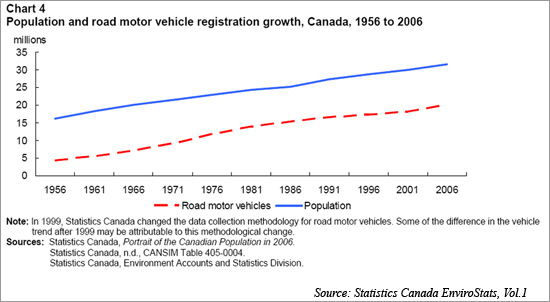Canada's Expanding Environmental Footprint
The report, part of a new bulletin on sustainability statistics called EnviroStats, points out that between 1956 and 2006, Canada’s population nearly doubled. Though many different factors influence Canadians’ impact on the environment, this population growth means a larger environmental footprint in absolute terms.
EnviroStats uses the example of vehicle ownership to demonstrate the connection between population and environmental pressure. A growing population demands more road vehicles, which in turn leads to higher levels of greenhouse gas emissions.
According to the report, the number of vehicles in Canada increased by 15.8 million over the last fifty years. Due to this rising number of vehicles, greenhouse gas emissions from road transportation in Canada increased by a third between 1990 and 2005.

This challenge seems to emphasize the value of innovation to offset growing environmental pressures. Advancements in sustainable transportation technologies could hold the potential to create a downward trend in environmental impacts despite population growth.
Innovation to reduce the amount of waste entering landfills is also significant. Reporting that landfills account for one quarter of Canada’s methane emissions, EnviroStats notes population growth contributed to increased residential waste production between 2000 and 2004.
However, the report highlights that much of this increase was offset by recycling programs, which have grown at both national and provincial levels. Evidently by 2004, Canadian households recycled 27% of their residential waste, up from 19% in 2000.
Progress is evident in other areas as well. According to the recent Households and the Environment Survey (HES) published by Statistics Canada, composting is another method of waste reduction which has grown in popularity: 27% of Canadian households composted in 2006, compared to 23% in 1994. Notably, however, the only province in which composting actually declined over this period was British Columbia.
The HES also revealed that Canadians are attempting to conserve energy. According to the study, six in ten Canadian households now use energy-saving compact fluorescent light bulbs, a triple jump in use.
More households also have water-saving appliances, such as low flow toilets and showerheads, which reduce both water consumption and the use of energy for heating water.
The survey also turned up some interesting information on drinking water habits. Three out of every ten households drank bottled water predominantly in 2006, whether they had a municipal or private water supply.
The rest consumed water from the tap, but half of the households that did so treated the tap water in some way. While the majority treated their water to improve the taste or appearance, 40% did so to address concerns about possible bacterial contamination. This information, in addition to water quality scares in Ontario over the past decade, indicate that despite a reputation as having one of the world’s cleanest water supplies, many Canadians still feel a need to seek extra protection.
Identifying these hints of progress and areas for improvement is significant given that population growth is expanding Canada’s environmental footprint.
Despite some gains, the Households and Environment Survey implies that Canadians could still be doing more to protect their environment.
One less promising trend is the low rate of recycling of electronic waste, such as old computers and cell phones. Although nearly one-quarter of households with old computers or other electronics disposed of them at special waste depots or returned them to the supplier, almost 20% put them in the garbage, and just over one-third said they did not know what to do with them.
Other aspects of household behaviour have not changed greatly since the survey was last conducted during the mid-1990s.
For example, the use of chemical pesticides in 2006 was down only slightly from 1994 levels, except in Quebec, where the share of households applying lawn and garden pesticides plunged by one-half over this period.
The HES also reported that the majority of Canadians traveled to work alone in a vehicle: 57% of commuters drive in warmer weather, while the colder Canadian days send 64% of Canadians to work in their vehicles.
Given EnviroStats’ conclusion that the number of cars on Canadian roads is rising, this persistently high percentage of single occupancy vehicles suggests the type of environmental pressure coinciding with population growth.
Notably, the environmental implications of population growth in Canada vary between provinces. With the highest population growth rates in Canada, Alberta, British Columbia, and the three territories, these regions can expect extra pressure on their local environments in the coming years.
Regardless of regional differences, as Canada’s population continues to expand, so does the need to address environmental pressures. Clearly, the market for technologies and services to address water, waste and pollution will continue to grow, and enhancing public awareness on environmental issues is required. Directing the creativity and innovation of the private sector towards sustainable development will remain important for mitigating Canada’s environmental footprint.
The full EnviroStats publication can be found here.
For More Information: Statistics Canada
You can return to the main Market News page, or press the Back button on your browser.

